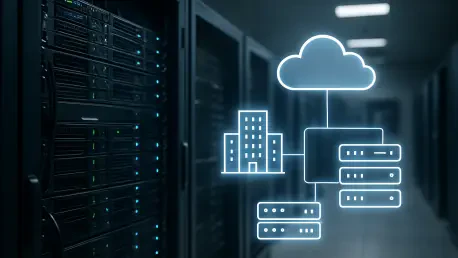In an era where data drives nearly every aspect of modern life, edge computing has emerged as a revolutionary force, transforming how information is processed by bringing computation directly to the source of data generation. Unlike the conventional cloud computing model that relies on distant centralized servers, this innovative approach significantly reduces latency, enhances data privacy, and lowers bandwidth costs. Such advantages position edge computing as a vital solution for industries requiring split-second responses, spanning from life-saving healthcare applications to the seamless operation of autonomous vehicles. The global market for this technology is witnessing unprecedented growth, reflecting a broader shift toward real-time, localized data handling in an increasingly connected world.
According to a comprehensive report by Kings Research, the edge computing market was valued at $156.20 billion in 2024, with projections indicating a remarkable climb to $1,123.30 billion by 2032. This trajectory, fueled by a compound annual growth rate (CAGR) of 28.40% from 2025 to 2032, underscores the pressing need for instant data processing amid the digital transformation sweeping across sectors. As billions of devices connect through the Internet of Things (IoT) and 5G networks expand globally, edge computing is no longer just an option but a necessity for maintaining competitive advantage and operational efficiency in a data-driven landscape.
Market Dynamics and Growth Factors
Drivers of Exponential Growth
The edge computing market is experiencing a surge, primarily propelled by the rapid expansion of IoT devices across diverse environments, from smart homes to sprawling industrial complexes. Billions of connected gadgets generate enormous data volumes daily, necessitating localized processing to ensure functionality without the delays inherent in cloud-based systems. For instance, autonomous vehicles rely on edge computing to process sensor data in real time for safe navigation, while remote healthcare solutions depend on it for immediate analysis of patient vitals during critical procedures. This ability to enable instantaneous decision-making positions edge computing as a cornerstone for innovation in sectors where timing is everything, highlighting its indispensable role in modern technological ecosystems.
Another pivotal catalyst for this market’s growth is the global rollout of 5G networks, which amplifies the demand for low-latency, high-bandwidth applications. Industries such as gaming, finance, and healthcare are leveraging edge infrastructure to deliver the seamless user experiences that 5G promises. The synergy between 5G and edge technology facilitates ultra-fast data transmission and processing closer to end-users, evident in initiatives like specialized zones that integrate edge computing with telecom networks. This convergence not only enhances service delivery but also drives widespread adoption across regions, reshaping connectivity standards and setting the stage for transformative digital experiences worldwide.
Challenges and Barriers
Despite its promising outlook, edge computing faces significant hurdles, with security vulnerabilities topping the list of concerns due to its decentralized architecture. The multitude of edge nodes dispersed across networks creates numerous entry points for cyber threats, including malware and data breaches, which could have devastating consequences in high-stakes industries like healthcare and automotive. A compromised edge device in a hospital setting, for example, could disrupt real-time monitoring of patients, while a breach in an autonomous vehicle system might endanger lives. These risks underscore the critical need for robust safeguards to protect sensitive data and ensure the integrity of operations in distributed environments.
To address these security challenges, industry stakeholders are deploying advanced protective measures, such as AI-driven threat detection and zero-trust security frameworks. These strategies focus on continuous monitoring and authentication at every access point, minimizing the likelihood of unauthorized intrusions. Endpoint protection systems are also gaining traction, fortifying devices against potential attacks. As reliance on edge computing grows, the emphasis on developing resilient security protocols becomes paramount, ensuring that the benefits of reduced latency and enhanced efficiency are not undermined by vulnerabilities that could erode trust and hinder market expansion.
Technological Innovations and Trends
Emerging Tools and Platforms
Technological advancements are reshaping the edge computing landscape, with containerization and orchestration tools leading the charge in simplifying application deployment across distributed environments. Containerization allows for lightweight, portable software packaging that can run consistently on various edge nodes, while orchestration platforms streamline the management of these applications, even in resource-constrained settings. A notable example is the introduction of platforms like Barbara 3.0, designed specifically for industrial edge environments. Such innovations enable scalable deployment, real-time monitoring, and remote updates, reducing dependence on constant cloud connectivity and enhancing operational adaptability for businesses navigating complex infrastructures.
Beyond deployment tools, the evolution of edge-specific solutions continues to drive efficiency and scalability in diverse applications. These platforms facilitate seamless workload management, allowing organizations to handle thousands of edge nodes with minimal overhead. This is particularly beneficial in sectors like manufacturing, where edge computing supports real-time data analysis for machine optimization without latency delays. By integrating such cutting-edge tools, companies can achieve cost-effective scalability, ensuring that their edge infrastructure remains agile and responsive to dynamic market demands, ultimately fostering innovation and maintaining a competitive edge in a rapidly evolving technological arena.
AI and ML Integration at the Edge
The integration of Artificial Intelligence (AI) and Machine Learning (ML) at the edge marks a transformative trend, enabling devices to perform sophisticated tasks locally without relying on centralized cloud servers. This shift reduces data transmission costs and latency, empowering systems to make autonomous decisions in real time. For instance, advancements in hardware, such as the STM32N6 series microcontrollers by STMicroelectronics, cater to automotive and industrial needs with low-latency processing for image and audio data. Such developments highlight how AI at the edge is revolutionizing applications, from smart surveillance to predictive maintenance, by embedding intelligence directly into devices.
Moreover, the synergy between AI and edge computing is paving the way for smarter, more independent systems that can adapt to changing conditions without external input. This is evident in scenarios where edge devices analyze environmental data on-site to optimize energy usage in smart grids or detect anomalies in industrial equipment before failures occur. The reduced need for constant cloud interaction not only enhances efficiency but also bolsters data privacy by keeping sensitive information local. As AI capabilities continue to evolve, their integration with edge infrastructure promises to unlock new levels of automation and insight, driving significant advancements across multiple industries.
Market Segmentation and Insights
Component and Deployment Breakdown
Delving into the composition of the edge computing market reveals a strong dominance of hardware, which accounted for $68.12 billion in revenue in 2024, driven by the demand for servers, gateways, and specialized edge devices. These components form the backbone of edge infrastructure, enabling the real-time processing that industries rely on for critical operations. Meanwhile, the software and services segments are gaining momentum as organizations seek comprehensive solutions to manage and optimize their edge environments. This balance between physical and digital elements reflects the multifaceted nature of edge computing, catering to both immediate infrastructure needs and long-term operational strategies.
Deployment trends further illustrate the market’s diversity, with cloud-based solutions holding a significant 41.07% share in 2024 due to their scalability and compatibility with IoT and AI applications. However, hybrid edge deployments are on a rapid rise, projected to grow at a CAGR of 33.42% through 2032. This approach combines on-premise and cloud capabilities, offering organizations greater control over sensitive data while leveraging the flexibility of cloud resources. Such hybrid models are particularly appealing to sectors balancing security with innovation, demonstrating how deployment strategies are evolving to meet varied organizational priorities in a dynamic market landscape.
Organization Size and Application Focus
When examining market adoption by organization size, large enterprises stand out as frontrunners, projected to command a 62.52% revenue share by 2032, thanks to substantial IT budgets and early integration of IoT and cloud technologies. These entities often have the resources to invest in extensive edge infrastructure, enabling them to capitalize on benefits like reduced latency and enhanced data processing across global operations. Their dominance highlights a trend where scale and financial capability drive technological leadership, positioning large organizations at the forefront of leveraging edge computing for competitive advantage in data-intensive industries.
In contrast, small and medium enterprises (SMEs) face challenges in adopting edge computing due to limited resources and infrastructure constraints, resulting in a slower uptake. However, their gradual integration of edge solutions is noteworthy, often focusing on niche applications that address specific operational needs. Meanwhile, by application, IoT stands as a powerhouse, expected to reach $404.09 billion by 2032 with a CAGR of 33.45%. Beyond IoT, applications like predictive maintenance and robotics are also expanding, driven by the need for local data processing to minimize downtime and enhance automation, showcasing the broad utility of edge computing across varied use cases.
Regional and Regulatory Perspectives
Global Growth Variations
Regionally, North America leads the edge computing market with a 33.19% share valued at $51.84 billion in 2024, underpinned by extensive 5G rollouts and robust technological infrastructure. Strategic partnerships between cloud providers and telecom operators have further solidified this dominance, enabling ultra-low latency services for sectors like healthcare and finance. Initiatives integrating edge computing into telecom networks exemplify how the region is harnessing advanced connectivity to support smart city developments and other data-intensive applications, setting a benchmark for global adoption and innovation in localized data processing.
Meanwhile, the Asia-Pacific region is poised for the fastest growth, with a projected CAGR of 32.24% through 2032, driven by high smartphone penetration and widespread industrial IoT adoption. Investments in data centers and connectivity infrastructure are accelerating digital transformation across countries like India and Indonesia, positioning the region as a burgeoning hub for edge computing. This rapid expansion reflects a unique blend of consumer-driven and industrial demands, highlighting how diverse economic landscapes can fuel technological advancements tailored to local needs, and signaling significant potential for market players eyeing global outreach.
Compliance and Policy Challenges
Regulatory frameworks introduce a complex layer to the edge computing market, particularly in regions with stringent data privacy and cybersecurity laws. In Europe, directives such as the Network and Information Security Directive 2 (NIS2) impose rigorous requirements on critical infrastructure, compelling edge computing providers to prioritize robust security measures. These mandates, while essential for safeguarding distributed systems, often increase operational costs and complexity, challenging companies to balance compliance with innovation. Such policies reflect a global emphasis on securing decentralized networks, shaping how edge solutions are designed and deployed in regulated environments.
Similarly, in Asia, regulations like China’s data localization laws mandate that sensitive information be processed within national borders, affecting how edge computing architectures are structured. Japan’s Act on the Protection of Personal Information (APPI) adds further compliance demands, requiring meticulous handling of data at the edge to adhere to privacy standards. These regional policies underscore the necessity for market players to adapt their strategies to local legal landscapes, ensuring that edge deployments not only enhance efficiency but also meet stringent regulatory expectations, a critical factor in sustaining growth and trust across international markets.
Looking Ahead: Shaping the Future of Connectivity
Reflecting on the trajectory of edge computing, it’s evident that this technology has already begun redefining the digital landscape by addressing the critical need for real-time data processing in a hyper-connected world. The remarkable growth projected from a valuation of $156.20 billion in 2024 to over a trillion dollars by 2032 speaks volumes about its transformative impact across industries. Challenges such as security vulnerabilities and regulatory complexities have been acknowledged as significant hurdles, yet the industry responds with innovative solutions like AI-driven security and advanced orchestration tools, demonstrating resilience and adaptability in the face of evolving demands.
Moving forward, stakeholders must prioritize the development of robust cybersecurity frameworks to safeguard distributed edge environments while navigating the intricacies of global compliance requirements. Investment in scalable technologies, such as containerization and AI integration, should be accelerated to meet the growing appetite for localized processing power. Collaboration among tech giants and emerging players alike will be crucial in driving standardized solutions that balance efficiency with security. As edge computing continues to underpin innovations in IoT, 5G, and beyond, a proactive approach to these priorities will ensure that its potential to revolutionize connectivity and operational efficiency is fully realized in the years ahead.









